BLOG
How Much Does It Cost to Install a New Gas Furnace?
 The need to buy a new furnace typically happens when your old one fails, or repairs have become too frequent or too costly. The good news is there are many options today. New models are extremely energy efficient and will save you a lot of money in energy costs compared to your old furnace. In fact, the energy savings may be a valid justification for replacing rather than repairing a worn out furnace. Here’s what Denver homeowners should consider when pricing a new furnace installation.
The need to buy a new furnace typically happens when your old one fails, or repairs have become too frequent or too costly. The good news is there are many options today. New models are extremely energy efficient and will save you a lot of money in energy costs compared to your old furnace. In fact, the energy savings may be a valid justification for replacing rather than repairing a worn out furnace. Here’s what Denver homeowners should consider when pricing a new furnace installation.
Types of Furnaces
Oil furnaces, while still available in some places, have mainly been replaced by natural gas. Natural gas furnaces are the most common type used in Colorado. Electric heat and heat pumps are other options. Electric heat systems can be very costly to operate and heat pumps, while gaining popularity in some places, don’t work well in cold climates.
A natural gas furnace can cost anywhere from $2,000 to $14,000. Chances are there is a model that fits your needs and budget. According to Home Advisor, most people spent between $2,298 and $5,550.
Heat Output Needed
Furnaces are rated by how many BTUs (British Thermal Units) they use in an hour. A BTU is the amount of energy needed to raise one pound of water one degree Fahrenheit. An average home uses a furnace rated 60,000 BTUs. People often buy furnaces with greater heat output than they need in order to ensure that it will provide enough heat. Not only is this unnecessary, it is counter productive. A furnace that is too big for the space will be less efficient and more expensive to operate because it will cycle on and off more often to maintain the desired temperature. This also creates additional wear and tear on the unit. Your HVAC professional will accurately measure your home and recommend the appropriate size furnace.
Furnace Efficiency
Energy efficiency has dramatically improved over the past 20 years. Older furnaces were rated 80% efficient, meaning 20% of the heat generated was wasted. Today’s higher efficiency furnaces are rated 90% or above for efficiency. Greater efficiency means lower energy costs, a factor that should be considered in the overall cost of the furnace.
Staging
Furnaces typically come in either one stage or two stage. One stage, which means it always runs at full power, is most common. Two stage furnaces are designed to run in first stage (low fire) for approxametly ten minutes, if thermostat is not satisfied within the ten minutes, the second stage will be energized utilizing 100% of heat output. Most furnaces have a permanent split capacitor motor, this type of motor has very expensive operating costs incomparison to the variable speed motor. Variable speed blowers adjust the rate CFM (airflow) is delivered when lessor more is needed. This adds to the efficiency of the furnace, significantly helps with temperatures differentials between floors and rooms – and it is quieter, too!



